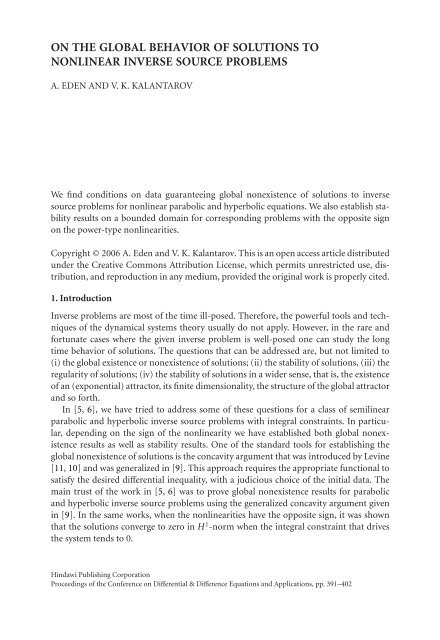DIFFERENtIAl & DIFFERENCE EqUAtIONS ANd APPlICAtIONS
DIFFERENtIAl & DIFFERENCE EqUAtIONS ANd APPlICAtIONS
DIFFERENtIAl & DIFFERENCE EqUAtIONS ANd APPlICAtIONS
Create successful ePaper yourself
Turn your PDF publications into a flip-book with our unique Google optimized e-Paper software.
ON THE GLOBAL BEHAVIOR OF SOLUTIONS TO<br />
NONLINEAR INVERSE SOURCE PROBLEMS<br />
A. EDEN AND V. K. KALANTAROV<br />
We find conditions on data guaranteeing global nonexistence of solutions to inverse<br />
source problems for nonlinear parabolic and hyperbolic equations. We also establish stability<br />
results on a bounded domain for corresponding problems with the opposite sign<br />
on the power-type nonlinearities.<br />
Copyright © 2006 A. Eden and V. K. Kalantarov. This is an open access article distributed<br />
under the Creative Commons Attribution License, which permits unrestricted use, distribution,<br />
and reproduction in any medium, provided the original work is properly cited.<br />
1. Introduction<br />
Inverse problems are most of the time ill-posed. Therefore, the powerful tools and techniques<br />
of the dynamical systems theory usually do not apply. However, in the rare and<br />
fortunatecaseswherethegiveninverseproblemiswell-posedonecanstudythelong<br />
time behavior of solutions. The questions that can be addressed are, but not limited to<br />
(i) the global existence or nonexistence of solutions; (ii) the stability of solutions, (iii) the<br />
regularity of solutions; (iv) the stability of solutions in a wider sense, that is, the existence<br />
of an (exponential) attractor, its finite dimensionality, the structure of the global attractor<br />
and so forth.<br />
In [5, 6], we have tried to address some of these questions for a class of semilinear<br />
parabolic and hyperbolic inverse source problems with integral constraints. In particular,<br />
depending on the sign of the nonlinearity we have established both global nonexistence<br />
results as well as stability results. One of the standard tools for establishing the<br />
global nonexistence of solutions is the concavity argument that was introduced by Levine<br />
[11, 10] and was generalized in [9]. This approach requires the appropriate functional to<br />
satisfy the desired differential inequality, with a judicious choice of the initial data. The<br />
main trust of the work in [5, 6] was to prove global nonexistence results for parabolic<br />
and hyperbolic inverse source problems using the generalized concavity argument given<br />
in [9]. In the same works, when the nonlinearities have the opposite sign, it was shown<br />
that the solutions converge to zero in H 1 -norm when the integral constraint that drives<br />
the system tends to 0.<br />
Hindawi Publishing Corporation<br />
Proceedings of the Conference on Differential & Difference Equations and Applications, pp. 391–402

















